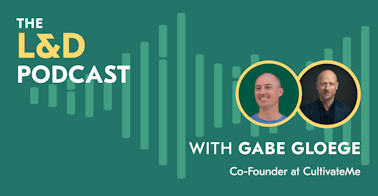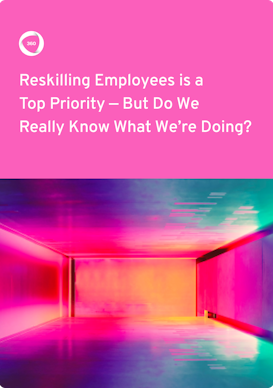

Training & Learning
Hard Skills in Context: Performance-Oriented Soft Skills Development With Expert Guy Wallace
L&D needs to answer a pressing question: Do we need to concede that we’ll never be able to accurately measure the impact of our soft skills development solutions?
If so, that’s an enormous amount of spending without knowing if we’re making enough of a difference.
In this episode of The Learning and Development Podcast, I speak with Guy Wallace, retired Performance Analyst and Instructional Architect, about how it is possible to plan, design, and deliver for real impact and how this is already working.
Read on to hear how every soft skill has the potential to be a hard skill, Guy’s trick to help you have meaningful stakeholder conversations, and how to build a team of master performers to make an impact on performance.
Soft skills are only hard skills out of context
In 1983, Joe Harless said that soft skills is a euphemism for hard skills, which we haven’t worked hard enough to define.
“What this means is that we don't begin with the end in mind, the terminal performance, or the outputs produced that lead to outcomes when we meet or don't meet stakeholder requirements,” Guy explains.
“We start with the skill, behaviour, or competency, and we're not thinking about it in the context of the learners who are performers who have a job to do. They've got tasks to perform that require knowledge, skills, and behaviours.”
As L&D leaders, we need to understand the performance context and what outputs stakeholders are trying to produce. We also need to understand that performance context varies from time to time, and therefore, our performance response should vary, too.
“So, perhaps you need to shift your behaviour or competency from one to another or apply the skill differently,” says Guy. “ It’s all about looking at and understanding a skill in a context.”
“So, perhaps you need to shift your behaviour or competency from one to another or apply the skill differently,” says Guy. “ It’s all about looking at and understanding a skill in a context.”

Skills are nothing without the right culture.
By downloading, you agree to our privacy policy.
Defining soft and hard skills
As Guy explains, every soft skill has the potential to be made into a hard skill when we look at them in context. If we don’t, they remain a soft skill.
“Soft skills are more educational than enterprise learning and development,” he says. “In education, you don't know exactly what Guy's job is going to be, but we know he needs to understand spreadsheets or how to do active listening, but we don't understand that context.”
In a corporate or enterprise learning environment, L&D isn’t enabled, encouraged, or asked to be authentic with training because, typically, everyone has more of an educational mindset. “Soft skills are not bad unto themselves unless we expect people to learn them and then immediately be able to apply them for success in their performance context, and that's where the issue lies,” Guy says.
From another angle, how often have you found yourself in training for what felt like someone else’s job? For example, if we look at line manager training, how often has L&D taught them how to coach or develop their team? But all they need is to learn how to run a budget or manage their own workload—the integral stuff that impacts their performance.
“Soft skills are not bad unto themselves unless we expect people to learn them and then immediately be able to apply them for success in their performance context, and that's where the issue lies.”
Guy’s ‘sneaky trick’ to impact terminal performance
When given a skill to address by a stakeholder, Guy uses a sneaky trick—doing his best active listening to ensure the requester knows that he understands their request.
“When they're comfortable that I haven't missed the boat on their request,” he says, “I will find someplace in the conversation to quickly segue to, ‘So, what would authentic practice with feedback look like?’ At that point, they might be able to tell me what the performance application is.”
Next, you can leverage content as a bookend to show or tell the learner how the training applies to their role, how it benefits them and the organization, and why they need to learn the content or skill. The bookend on the other side is practice with feedback that is authentic.
“Often, that's what we’re missing,” Guy explains. “We don't go that last mile to apply that in somebody's specific workflow. We have to have our eye on the terminal performance that we expect the learners to do and how we give them sufficient practice with feedback so they can learn something generically, but then learn how to apply that.”
Create a team of master performers and SMEs
A part of Guy’s process has always been to engage who he calls the master performers.
“You build a team of top performers and subject-matter experts, facilitate the definition of the performance, and then systematically derive the enabling knowledge and skills. And then, you design,” he says.
When assembling these teams, Guy will often bring in novice performers who show great promise for a fresh perspective on the role. “ It’s good to have a variety of people,” he says. “Then it's the facilitator's role to balance all the concerns that all these people have and capture the data needed for the team's next steps downstream.”
“You build a team of top performers and subject-matter experts, facilitate the definition of the performance, and then systematically derive the enabling knowledge and skills. And then, you design.”
First step in pivoting to performance-orientated development
If you’re looking to pivot to a performance-orientated approach to developing soft skills, Guy suggests you start with a series of quick self-assessments.
Understand your context: where you and your team are and what you know and don’t know. “The issue is that most of the time, people don't know what they don't know. They don't know if what they know is valid and appropriate in a different context,” Guy explains.
“So, you've got to decide where you are on your own learning and performance curve regarding performance-based learning,” he says. “Also, ask yourself, ‘Where are our clients and stakeholders in all of this? Are they hungry for this?’”
Thanks to Guy for sharing his insights with us! Check out our episode with Kenny Temowo about talent development at Netflix or Gabe Gloege on his framework for a skills-based approach to L&D.
Want more peer insights on transforming workplace learning? Sign up to become a member of the L&D Collective or you can subscribe (below 👇) to our weekly newsletter to receive our latest posts directly in your inbox.




